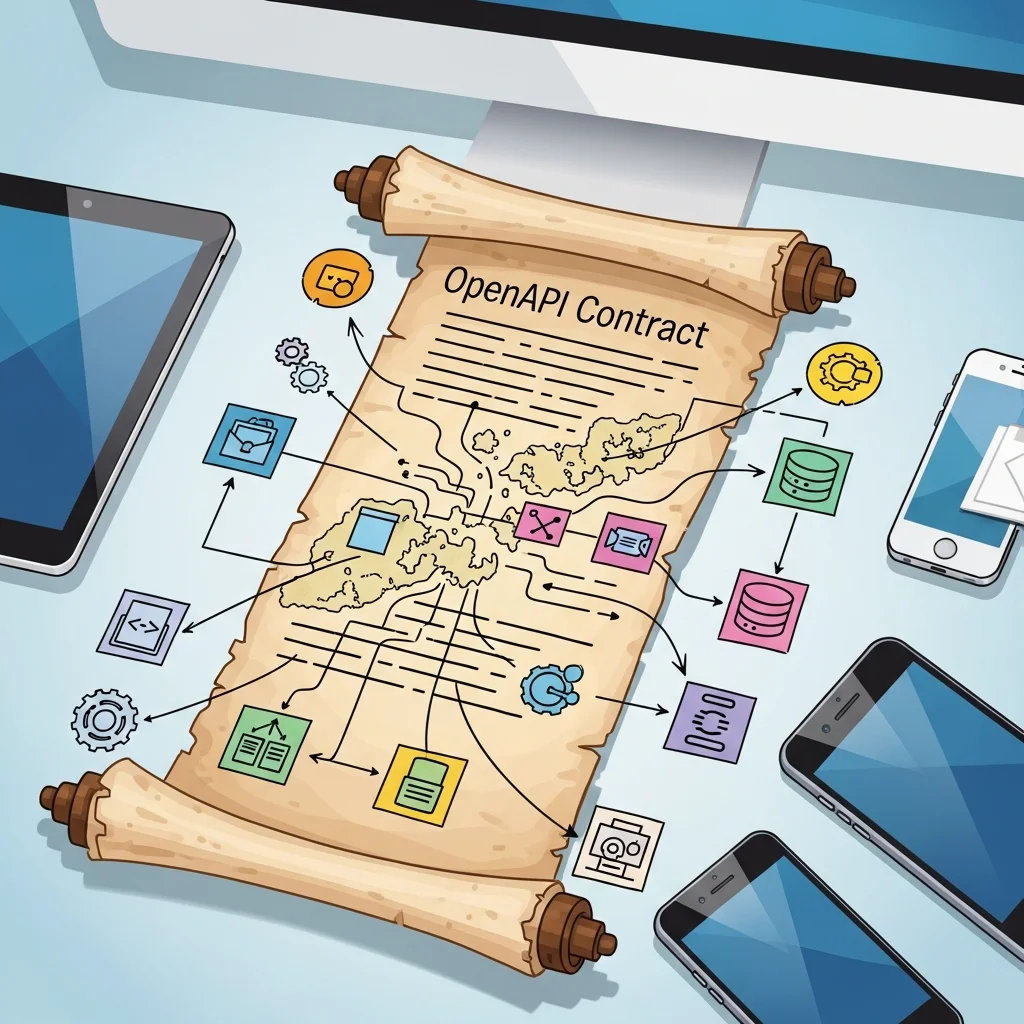API-first software development is an architectural and organisational approach in which APIs take centre stage when designing, building and managing software.
Summary of API-first software development
API-first software development is an architectural and organisational approach in which APIs take centre stage when designing, building and managing software. Instead of starting from a user interface or internal application logic, the API contract is defined and validated first, often using specifications such as OpenAPI. This enables teams to work in parallel, makes applications more scalable and simplifies the management of integrations.
Key topics in this article include the definition of API-first, the difference from API-led and 'API as an afterthought', the role of contract-first design and API specifications, the impact on software architecture and development processes, and typical advantages and disadvantages in practice. We also explore its relationship with microservices, composable architectures and modern frontend development.
Important takeaways covered in this article:
What API-first software development is and how it evolved historically
How API-first differs from traditional point-to-point integrations
Which benefits API-first offers for scalability, maintainability and developer experience
What risks and pitfalls organisations encounter during an API-first transition
Which design principles, forms of documentation and governance models are commonly used
Understanding and background of API-first software development
API-first software development is an approach in which application programming interfaces (APIs) are treated as primary products within a software architecture. An API defines how software components communicate with each other, for example via HTTP, JSON and REST or via alternative protocols such as GraphQL and gRPC. In an API-first context, the desired behaviour of a service is captured in an API specification before implementation and user interfaces are built.
Historically, APIs were often added to existing systems at a later stage, for instance so that third parties could retrieve certain data. This approach frequently led to inconsistent endpoints, limited documentation and a tight coupling to internal data models. API-first emerged as a response to these issues, fuelled by the rise of cloud-native development, microservices, mobile apps and integration platforms. As organisations increasingly open up their systems to partners and external developers, the quality and predictability of APIs have become more important.
A hallmark of API-first is that APIs are viewed as fully-fledged products with their own lifecycle, versioning and quality criteria. This applies to internal APIs within a single organisation as well as public APIs consumed by third parties. In design and governance, aspects such as backward compatibility, security and usage statistics are explicitly considered. The result is a more systematic and scalable integration approach than when APIs are added ad hoc.
Definitions and scope
Although the term API-first is used broadly, several recurring characteristics appear in many definitions. First, there is the concept of contract-first design, in which the API contract—often a machine-readable specification—is used as the single source of truth. Implementation, test code, documentation and client libraries can be generated from it or validated against it. Secondly, the emphasis lies on consistent design guidelines and standards so that APIs within an organisation are recognisable and uniform.
API-first should be distinguished from terms such as API-led or API management. API-led often refers to an integration pattern where different types of APIs, such as system APIs, process APIs and experience APIs, are used to support complex business processes. API management concerns tooling and processes to publish, secure and monitor APIs. API-first can be used alongside these concepts but primarily emphasises the design philosophy and development order. It is therefore both a technical and an organisational choice.
Architectural principles and design practices within API-first
API-first software development features several recurring architectural principles. One is a strong separation between interface and implementation. The API contract describes which resources, operations, parameters and error codes are available without exposing the underlying database schema or internal code. This promotes encapsulation and allows implementations to change—through refactoring or migration to other technology—while the contract remains stable.
A second key principle is design consistency. Many organisations define enterprise-wide guidelines for naming, versioning, error handling, pagination and authentication. For example, all resources must be self-identifying via uniform paths and error messages must be returned in a standardised format. This consistency makes it easier for developers to understand and use new APIs, thereby improving the developer experience.
Contract-first design is often supported by tooling that can author and validate API specifications in formats such as OpenAPI or AsyncAPI. Based on these specifications, mock services can be set up so that frontend and backend teams can develop in parallel. Test suites can verify whether the implementation actually matches the specification. This reduces integration issues and speeds up the feedback loop during development.
In modern API-first architectures the approach is frequently combined with microservices, composable systems and headless platforms. Each service exposes its own limited set of APIs with a clearly defined responsibility. Frontend applications, such as web interfaces built with frameworks like React or mobile apps, communicate with these APIs to access underlying domains. This loosely coupled structure supports scalability and enables individual components to be deployed independently.
Benefits, challenges and governance in API-first software development
A frequently cited benefit of API-first software development is parallel development. Because the API contract is specified and shared upfront, different teams can work simultaneously on frontend, backend and integrations. This shortens lead time and makes iterative development easier. In addition, a uniform and well-documented API layer lowers integration costs, as reused patterns shorten the learning curve for new projects and partners.
A second advantage is that API-first provides a better foundation for scalability and maintainability. Thanks to the clear separation between client and server, organisations can respond more quickly to changes in business logic or infrastructure without all consuming systems needing immediate modification. Moreover, an API-first approach makes it simpler to organise monitoring, security and rate limiting centrally. With API gateways and observability tooling, performance can be measured and abuse detected.
At the same time, API-first software development presents clear challenges. Establishing consistent design standards, managing version control and enforcing backward compatibility require discipline and governance. Without clear guidelines, the number of APIs can grow rapidly in an unmanageable way—often referred to as API sprawl. Organisations therefore usually implement some form of API governance, such as a centre of expertise or an architecture board that defines and enforces guidelines.
Another consideration is that API-first is not automatically the best choice in every situation. For smaller, internally used applications, the heavier emphasis on API contracts and documentation can introduce relatively high overhead. In such cases, a pragmatic mix may be chosen, where only critical domains are strictly API-first. This balances formal processes with development speed while retaining the benefits for integration and future-proofing.

What is meant by API-first software development?
API-first software development is an approach in which APIs are designed and specified before the underlying implementation and user interfaces are built. The API contract serves as the single source of truth, enabling different teams to work in parallel and making integrations predictable. It is both a technical and an organisational choice.
How does API-first differ from traditional integration approaches?
In traditional integration, APIs are often added to existing systems at a later stage, for example to expose data for a specific partner. This regularly leads to inconsistent endpoints and limited documentation. In an API-first approach, APIs are central to the architecture and are designed from the outset with reuse, scalability and governance in mind. As a result, they function better as stable building blocks within a larger ecosystem.
Is API-first only relevant for microservices architectures?
API-first is often associated with microservices because both approaches rely heavily on clear service boundaries and loose coupling. However, API-first is not limited to microservices. A contract-first design is also valuable in modular monolithic systems, integration platforms and headless content management. More important than the underlying deployment structure is the systematic way APIs are designed and managed.
What role do API specifications such as OpenAPI play in an API-first approach?
In an API-first approach the API contract is often recorded in a machine-readable specification, for example in OpenAPI format. This specification describes the available endpoints, parameters, responses and error codes. Development teams use the specification to generate mocks, automate tests and generate client code. This reduces the risk of implementation and documentation diverging and makes collaboration between teams easier.
What benefits does API-first offer organisations with many integrations?
For organisations with a large number of internal and external integrations, API-first primarily delivers greater predictability and control. Uniform design standards and a central overview of available APIs allow new integrations to be realised more quickly and reduce the risk of unexpected dependencies. In addition, an API-first approach makes it easier to apply security policies and access control consistently across all APIs.
Are there any drawbacks or risks associated with API-first software development?
API-first entails additional work in terms of design, documentation and governance. For small projects, this overhead can be relatively large if there are few integrations. Furthermore, an overly rigid governance model can slow innovation when every change requires a lengthy approval process. It is therefore important to choose a suitable level of formalisation that matches the organisation's scale and complexity.
How does API-first relate to terms such as API-led and composable architecture?
API-first is primarily a design and development approach in which APIs take centre stage when modelling functionality. API-led refers more to a pattern in which different layers of APIs play a role in exposing systems and processes. Composable architecture concerns assembling digital solutions from loose, reusable building blocks such as services and APIs. In practice these concepts are often combined, with API-first providing reliable building blocks within a composable landscape.



